Indonesia, as a tropical country, has a wealth of natural resources, such as the diversity of wildlife. Behind it all, there is a high risk of infectious disease transmission because it is estimated that up to now 70% of zoonotic diseases (infections that can spread from animals to humans) come from wild animals. It is from many types of infectious diseases. Therefore, we conduct specific research in one type of disease, sparganosis. What is sparganosis? Sparganosis is an infectious disease caused by tapeworm parasites of the genus Spirometra, where the worm can infect wild animals, especially cold-blooded animals such as reptiles and amphibians. Some case reports also state that humans were also infected with the Spirometra worm. However, it is very unfortunate that no one has reported in detail how the occurrence of this disease in wildlife. Cases of infection in humans tend to be caused by the close relationship between humans and wildlife.
The current phenomenon that is happening in our country is the emergence of a habit of adopting exotic pets from wildlife and the habit of consuming meat from wild animals such as snakes, lizards, frogs, and monitor lizards as extreme culinary. Humans can be infected with sparganosis when they eat meat from the infective Spirometra tapeworm stage. Spirometra worms found in many types of meat and innards which are used as the main ingredients of extreme culinary. If the food is not cooked with proper temperature, the worm in its infectious stage may still be alive and ready to infect our bodies, especially when those extreme culinary enthusiasts prefer eating meat served in raw or half-cooked.
Furthermore, we also argue that individuals who are close to this phenomenon are more at risk of being infected with sparganosis, especially if they lack attention to hygiene and sanitation. Until now, there have been several individuals who are specialized in the breeding of wild animals. The breeding results are sent as a culinary ingredient and used as exotic pets. Some of the wild animals used as the main culinary ingredients are also caught from nature. To find out how sparganosis disease develops in wild animals, we conducted preliminary research on wild animals that are often found as exotic pets and extreme culinary ingredients. It was focused on snakes to get a clear picture of sparganosis case from wild caught snakes and breeding process.
Method and Results
The research was successful in detecting Spirometra worm infections which caused sparganosis in snake species Dendrelaphis pictus or slap snake. Furthermore, 378 samples were collected from Mojokerto city and regency, East Java. The samples obtained came from breeders and wild catches. The collected snake samples have a variety of ages, so they are categorized according to age range, from young snake size, juvenile size, and adult size. Euthanation and necropsy techniques were carried out to determine the distribution of Spirometra worm infection in parts of subcutan tissue, coelom and musculus or meat from snake samples examined.
The results obtained were then analyzed for prevalence, which was then described in each sample category. The total prevalence of the entire sample is 50.85%, where the sample of snakes originating from the breeders have 70.7% prevalence rate and snakes originating from wild catches have a prevalence rate of 48.7%. More than half (56.6%) of Spirometra worms were found in the musculus or snake meat, and 29.5% were found in subcutan tissue, and 13.8% were found in the coelom section.
The results of this research have implications that wild animals that have been specially bred by several breeders as pets and wild animals have an equal chance in the incidence of sparganosis infection as the prevalence rates obtained are high. In the results of this research, we suggest the development of Standard Operational Procedure (SOP) on aspects of sparganosis disease control especially in wildlife in Indonesia as a reference for preventive measures to prevent transmission to humans and treatment measures if positive samples are found. So far, there are no specific references regarding sparganosis control measures in animals, because sparganosis is still categorized as a neglected tropical disease.
Reports of specific sparganosis events in wildlife, domestic animals, and livestock in Indonesia are very minimum, even though this disease can spread to humans. The lack of sparganosis epidemiology data around the world in both humans and animal species is a challenge for further research on an ongoing basis.
Author: Aditya Yudhana, drh., M.Si.
Details of the research available at:
http://www.veterinaryworld.org/Vol.12/June-2019/18.pdf
Aditya Yudhana, Ratih Novita Praja, and Arif Supriyanto. (2019). The medical relevance of Spirometra tapeworm infection in Indonesian Bronzeback snakes (Dendrelaphis pictus): A neglected zoonotic disease. Veterinary World, 12(6): 844-848;





